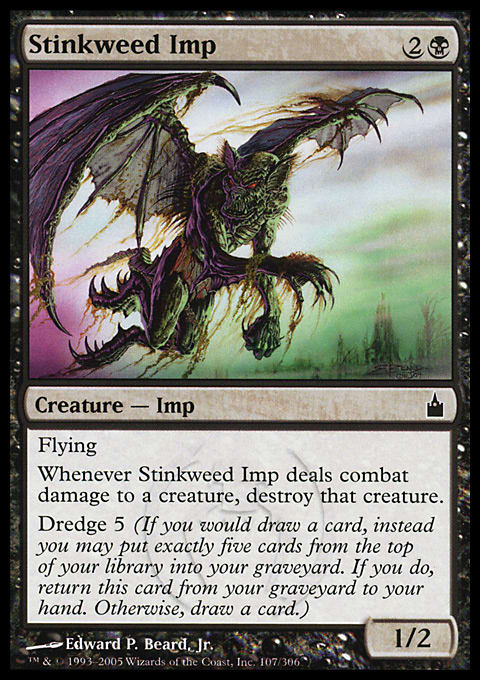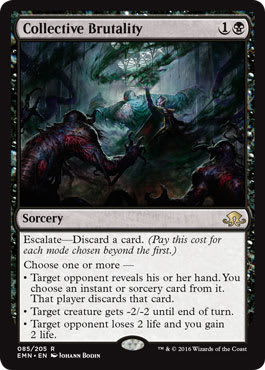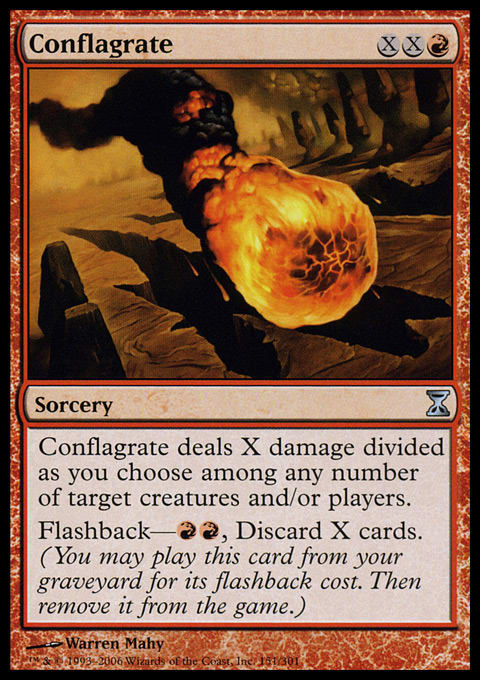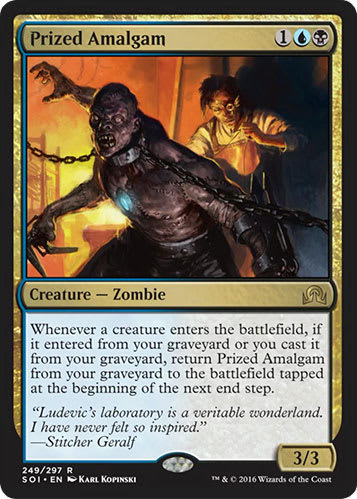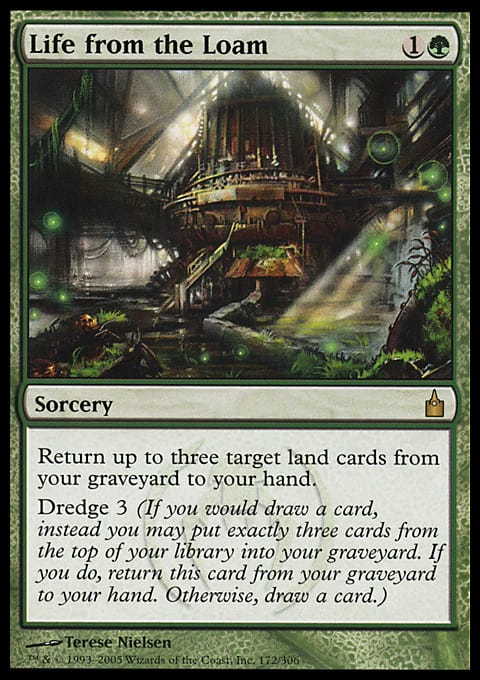Another week, another tough finals loss for your boy 40-Card. Another “what if?” Another “but if I’d played slightly differently, would I have salvaged one of those games?” Typically, dwelling on losses is counterproductive, but occasionally it is worth it to reflect on the reasons why a win seemingly slipped through your fingers. Of course, Dredge makes winning easy, so the few critical decision points of the tournament often stand out even more brightly in contrast to the many games where a great opening hand leads to a quick and mindless win on the third or fourth turn. The main decisions with this deck involve choosing when to cast the card draw spells, what removal or countermagic to play around, and how much of the core of the deck can be trimmed in order to fit in sideboard interaction. Whenever you get one of those decisions wrong, there is a risk that it snowballs into a game loss, but fortunately, Dredge is mostly pretty forgiving. As long as you remember your triggers and don’t run headlong into graveyard hate, you’ll be 90% of the way to Dredge mastery. Don’t get me wrong; I’m no Dredge expert, but the information contained in this primer constitutes most of the knowledge I took to make it to the finals of the SCG Open this past weekend in Baltimore, and there’s no reason why it can’t do the same (or better) for you.
Why Dredge?
Quite simply, the deck is about 80-90% as good as it was before the banning, but no one is playing enough sideboard hate to properly combat it. Long gone are the days of three Ravenous Traps, four Rest in Peace, four Leyline of the Void, or similar levels of interaction. People are playing Grafdigger's Cage, which does good work, but doesn’t spell the end of the game the way Rest in Peace does. You can still Dredge and cast your Stinkweed Imps, you can still use the Life from the Loam + Sheltered Thicket engine to draw into your removal spells, and you still have great card velocity and card advantage alongside your mediocre creatures. The hate is not quite prevalent enough and not quite targeted enough to shut down your game plan often enough to bring your win percentage down to a reasonable level. That’s number one.
Number two is the fact that no one was building their Dredge decks correctly before. Yes, I said it. All the people who had Insolent Neonate in their decks were unquestionably wrong, for a multitude of reasons. Insolent Neonate, as a one-shot Dredge enabler, has a power level ceiling of approximately “Tome Scour” level. Occasionally you can discard a card that really needs to be in the graveyard and get a free Dredge out of a card that was already in the ‘yard, but when the biggest draw to Neonate is that “hey, you can sometimes combine this card with a Stinkweed Imp to get a turn-one self-mill for five!” you have a low-power problem. I prefer for all my cards to be a bit more interactive, a bit more powerful, and a bit more flexible. Collective Brutality is that card. Where Insolent Neonate is Tome Scour, Brutality is Cabal Therapy and Cabal Pit rolled into one. It is the card that makes Dredge great against Burn, Collected Company, and a number of combo decks. It is the card that lets you laugh at the pathetic Scavenging Ooze your opponent slammed down in Game 1, hoping to earn a free win. It takes Anger of the Gods or Summoner's Pact, Through the Breach or Ad Nauseam, Collected Company or Boros Charm, and it does it in Game 1. These are matchups where you gain significantly more time by casting a disruption spell than you would by milling five cards on turn one. Hell, Neonate isn’t even good at speeding you up a turn unless you also have a Faithless Looting or Cathartic Reunion, as you’ll still be slow-dredging on turn two with just Neonate and a dredger. Cathartic Reunion by itself does most of the work of Insolent Neonate, while allowing you to dig meaningfully for your Dredge cards in the games where your draw is less-than-perfect. Neonate is a leftover card from the Golgari Grave-Troll era, where you could realistically hope to dredge five or six on the first turn. Now, you only have a cap of five, and only four Stinkweed Imps to give you that potential nut draw. And when your nut draw is something you could have achieved with a Tome Scour, you need to re-evaluate.
Now, the Dredge core was already powerful enough to be favored against most Death's Shadow decks, midrange piles, and many of the random second-tier decks that players seem to love. Upgrading with Collective Brutality not only improves the previously-shaky Burn and Abzan Company matchups, but opens up a ton of sideboard space. You can now play your own Leylines of the Void, and have a plan against the mirror, Krark-Clan Ironworks combo, Grixis decks, and Living End. You can play three+ sideboard Thoughtseize in order to hedge against combo decks, and you can fit in plenty of anti-hate answers in the remaining slots. Let’s talk about those cards.
The first thing to notice is that there are no Abrupt Decays in this sideboard. Engineered Explosives is where you want to be, without a doubt. Not only does it answer all the same permanents that Decay answers, but you can often sculpt a game plan around it and just destroy certain draws from decks like Elves, Merfolk, Abzan, Affinity, and Abzan Company. Two- and three-for-ones are not uncommon. Opponents will gleefully drop two Grafdigger's Cages or two Rest in Peaces into play and see both lost, which brings me to my next sideboard card . . .
Maelstrom Pulse does so much more for this deck than Abrupt Decay, it’s incredible. Number one, it hits Leyline of the Void, while also hitting Scavenging Ooze, Tarmogoyf, Devoted Druid, and other creatures that Nature's Claim doesn’t answer. Number two, you can get two-for-ones with the card against many Death's Shadow, Jund, Affinity or Company draws, as most opponents are completely unprepared to play around a Maelstrom Pulse blowout. The next time you clean up a pile of opposing Spirit tokens, a Gideon Jura, or a Leyline of the Void with no fuss, thank me. Then, pile in on your hapless opponent with a stack of Zombies, Vampires, and Illusions, and thank me again.
The List
Dredge ? Modern | Ben Friedman
- Creatures (19)
- 1 Haunted Dead
- 2 Golgari Thug
- 4 Bloodghast
- 4 Narcomoeba
- 4 Prized Amalgam
- 4 Stinkweed Imp
- Instants (2)
- 2 Darkblast
- Sorceries (19)
- 3 Conflagrate
- 4 Cathartic Reunion
- 4 Collective Brutality
- 4 Faithless Looting
- 4 Life from the Loam
- Lands (20)
- 2 Mountain
- 1 Blackcleave Cliffs
- 1 Blood Crypt
- 1 Ghost Quarter
- 1 Sheltered Thicket
- 2 Bloodstained Mire
- 2 Dakmor Salvage
- 2 Gemstone Mine
- 2 Stomping Ground
- 2 Wooded Foothills
- 4 Copperline Gorge
- Sideboard (15)
- 3 Engineered Explosives
- 1 Vengeful Pharaoh
- 4 Leyline of the Void
- 1 Ancient Grudge
- 3 Maelstrom Pulse
- 3 Thoughtseize
I could theoretically see tinkering with the sideboard, but I’m not going to. Why mess with success? Two maindeck Darkblasts were a hedge against Abzan Company and Affinity, while being 75% as good as Golgari Thug in other matchups. If you were so inclined, you could cut one for a third Thug and possibly cut the other for some sweet one-of. Lightning Axe, Goblin Lore or Burning Inquiry, perhaps? Gemstone Caverns? A basic Forest, to allow you to fight through Blood Moon? The world is your oyster!
Sideboarding
Okay, so let’s entertain a hypothetical scenario for a minute. You’re playing Dredge, and you win Game 1 pretty easily. You have Faithless Looting into Cathartic Reunion on the play, and put 10 power on the table on turn two. Cool! But your opponent furiously grabs their sideboard and starts aggressively jamming cards into their deck, muttering to themselves about “stupid Dredge”. What do you do? Don’t panic! There are some easy formulas for sideboarding with the deck that guarantee you a decent post-board game against all but the most hateful opponents.
If Darkblast is bad, it gets cut immediately. That’s step one. I also almost always cut a land, either a Dakmor Salvage or a Ghost Quarter, depending on if Quarter is useful in the matchup. Three cards down, just like that! Collective Brutality is cuttable or shave-able if your opponent is playing a deck where it doesn’t do much. Think G/x Tron, Eldrazi Tron, Jund Death's Shadow, Bogles, and to a lesser extent Grixis Shadow, Affinity, Eldrazi and Taxes, the mirror match, Living End, or certain control decks. I’d be willing to cut one or two of this card in plenty of matchups, and would lose all my copies of it against matchups where none of the modes do much.
Once you’ve evaluated the number of Brutalities, Darkblasts, and the land to cut, it’s time to look at your payoff cards. A single Conflagrate is a good cut (unless your opponent is playing creatures which are particularly vulnerable to a big fireball), as is either a Narcomoeba or a Bloodghast (depending on whether you need blockers or need to grind them out more). The Haunted Dead is a good card to cut if you don’t expect Surgical Extraction and don’t need flying blockers. You can also cut down to a single Golgari Thug, though I would be reluctant to do this if I were also cutting my Darkblasts and a Dakmor Salvage. If you are keeping your Darkblasts, the Thugs are redundant and can easily leave. Very rarely, if the matchup promises to be speed-based and with little need to grind out opponents (think Ad Nauseam), a single Life from the Loam can also be cut. The only cards I never touch are my Amalgams, my Imps, my Reunions, and my Lootings.
What to bring in? Well, bring in Leyline of the Void against the mirror match, Grixis, Living End, and Krark-Clan Ironworks. I’d consider bringing it in against Melira (but not Vizier) Company, but any other decks for it are likely super-fringe players. Bring in five or six of the Explosives and Pulses against midrange decks like Jund, creature piles like Merfolk and Elves, and Company combo decks. Bring in Pulse if your opponent is playing Black and could have Leyline of the Void. Bring in Pulse and EE if your opponent could have Rest in Peace or if they’re likely to have Grafdigger's Cage (think Jund/Abzan, not Valakut). Bring in a few EE against Burn as a hedge against Rest in Peace. Bring in Thoughtseize against combo decks and control decks, as well as decks that are likely to have Rest in Peace and/or Blood Moon (but probably not Affinity). Bring in Vengeful Pharaoh against various types of Death's Shadow, and the Grudge against Affinity, Ironworks, Lantern, and Eldrazi Tron. If you’re absolutely stuck, try shaving a single one of your Pulse/EE slots, a Narcomoeba, or a Collective Brutality. If there’s some matchup that’s giving you fits (and it’s a normal, commonly played deck), feel free to ask for advice! Obviously this deck ebbs and flows with the metagame, but as it currently stands it’s hard for me to see it ever being a bad choice.
How to Play Dredge
Well, to start, there are different strokes for different folks with this deck. Jim Davis even told me after the tournament, “I play a lot of Dredge and I was completely baffled by some of your choices. I suppose it worked out for you, but you play Dredge way differently than I do.” I tend to play it conservatively, knowing that my Loam engine will often grind people into the ground as long as they can’t disrupt it or break through my creatures. Whenever I diverge from this general philosophy, I find myself losing more. I also tend to save life on my shocklands more than most people, which sometimes leads to me playing a Faithless Looting on turn two when it might just be better to jam it on turn one and see what it turns up. I tend to keep more hands than others I’ve seen with Dredge, being comfortable keeping one-landers with Faithless Looting on the draw against non-Thoughtseize decks, or keeping one-landers with two Lootings and no Dredger on the play. Some general guidelines, though, are as follows:
Your best opening hands have a dredger, a Looting or Reunion, and two lands. Mulligan fairly aggressively if your hand has no draw spell, unless it also has a dredger and a Brutality to get that dredger in the yard (hopefully alongside a Bloodghast or Amalgam). On the play, against specific known decks, it’s acceptable to keep hands with Life from the Loam and no turbo-draw spell, but I wouldn’t typically recommend it. Your deck mulligans exceptionally well; take advantage of that!
You only need to get to two lands to Loam back the rest and be comfortable for the remainder of the game. Two lands (including a Green source) is perfect! Do try to play around Ghost Quarter or Spreading Seas if you can by getting a second Green source, because you really do need Green mana to turn your engine on to the maximum (and to fuel your Conflagrates!)
Sequence your land drops at the last possible moment. You want to try to hit Bloodghasts and reanimate them to trigger your Prized Amalgams, and you won’t get there by playing your third land and then casting your Cathartic Reunion.
Be careful not to mill over both of your Stomping Grounds with no Copperline Gorge or Gemstone Mine in hand. Sometimes I’ll fetch the shockland just to prevent this tragedy, especially if I’ve already hit one.
If you’re playing around Anger of the Gods, you can decline to bring back your Narcomoebas, and when you play a fetchland, you can decline to bring back your Bloodghasts, just to protect the Amalgams. Crack the fetchland during the opponent’s second main phase to give yourself a guaranteed single attack with the Amalgams. You can also only bring back one Bloodghast in order to trigger Amalgams and save the other one or two Vampires for a finishing blow post-Anger of the Gods.
Sheltered Thicket can protect your dredgers from Surgical Extraction! Just cycle the Thicket in response to the Surgical and dredge the targeted card safely into your hand. Fetchlands can protect your Bloodghasts from Surgical Extraction in the same way.
Sometimes you don’t want to dump all of your dredgers in the graveyard in order to save some juice for after your opponent breaks his or her Relic of Progenitus or Nihil Spellbomb. If you can, it pays to keep one dredger (preferably the self-enabling Life from the Loam) in reserve to start up again post-exile. I also often dump a Stinkweed Imp and a Prized Amalgam into the bin off a turn-one Looting instead of two Stinkweed Imps in order to potentially spike a Narcomoeba or Bloodghast on turn two’s draw step and immediately get some power into play. Don’t just mindlessly dump your dredgers!
Stinkweed Imp is a great blocker against Affinity and Death's Shadow. Keep that in mind, and don’t be afraid to cast an army of Imps to hold off a stack of Death's Shadows or an Ornithopter with a Cranial Plating.
Against Burn, a castable Collective Brutality trumps basically everything else in terms of keepable hands. If your hand isn’t a top 10% hand, and it doesn’t have a Brutality, send it back for a fresh chance at a heavy hitter hand!
I’m sure there are more tips and tricks that will come up for you in your exploration of the graveyard, but these should be more than enough to get you started. If you’ve never Dredged before, try it out! It’s refreshingly different from regular Magic and allows you to explore the game from a completely different axis than you might be used to. There’s no guarantee that the deck will be legal in Modern forever, so now is the perfect time to Dredge. Your opponents may call you brainless for playing it, but you can call them brainless right back after your zombies come calling for some gray matter!
















